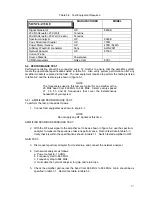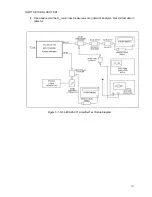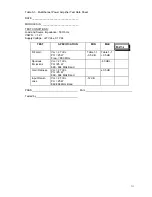
17
Table 5-2. Test Equipment Required
MENCLATURE
MANUFACTURER
MODEL
Signal Generator
H.P.
8656B
20 dB Attenuator, 250 Watt
Tenuline
20 dB Attenuator, 20 Watt (2 each)
Tenuline
Spectrum Analyzer
H.P.
8560E
Coax Directional Coupler
H.P.
778D
Power Meter / Sensor
H.P.
437B / 8481A
Arbitrary Waveform Generator
Sony
AWG2021
Network Analyzer
H.P.
8753C
Current Probe
Source Diskette
Powerwave
CDMA Generator
Noise Com
800-1
5-4. PERFORMANCE TEST
Performance testing should be conducted every 12 months to ensure that the amplifier system
meets the operational specifications listed in table 5-3. Also verify system performance after any
amplifier module is replaced in the field. The test equipment required to perform the testing is listed
in table 5-2, and the test setup is shown in figure 5-1.
NOTE
The frequencies used in this test are typical for an amplifier with a
25 MHz band from 869 MHz to 894 MHz. Select evenly spaced
F1, F2, F3, and F4 frequencies that cover the instantaneous
bandwidth of your system.
5-4.1. AMPLIFIER PERFORMANCE TEST.
To perform the test, proceed as follows:
1.
Connect test equipment as shown in figure 5-1.
NOTE
Do not apply any RF signals at this time.
AMPLIFIER SPURIOUS EMISSIONS TEST:
2.
With the RF input signal to the amplifier set to be as shown in figure 5-2, use the spectrum
analyzer to measure the spurious emissions performance. Record test data in table 5-3.
Verify that it is within the specifications shown in table 1-1. Switch tested amplifier to OFF.
GAIN TEST:
3.
Disconnect spectrum analyzer from test setup, and connect the network analyzer.
4.
Set network analyzer as follows:
a. Power output to -13 dBm.
b. Frequency start to 869 MHz.
c. Frequency stop to 894 MHz.
d. Normalize the network analyzer for gain and return loss.
5.
Check the amplifier gain across the band from 869 MHz to 894 MHz. Gain should be as
specified in table 1-1. Record test data in table 5-3.





































